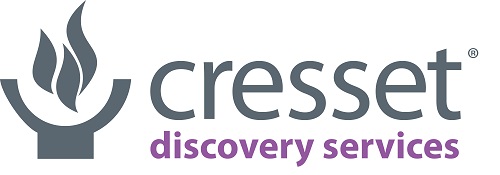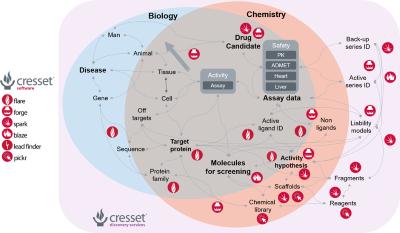Streamlining molecular discovery

Dr Martin Slater, Director of Consulting Services, discusses where outsourcing computational chemistry can complement internal research and gives insight into the ways Cresset Discovery Services CADD scientists help customers deliver on their corporate objectives.
What types of organizations do you collaborate with?
Computational methods can be applied to any type of molecular discovery, so although we primarily work with pharma and biotech, we also collaborate with teams from the agrochemical and flavors and fragrances industries. Cresset specializes in both detailed molecular modeling analyses and high throughput cheminformatics approaches. These methods are certainly very advantageous to drug discovery, but are also applicable to physical property prediction, toxicology prediction, patent protection and protein modelling.
.jpg)
Figure 1: Cresset Discovery services collaborates with a wide range of industries.
Cresset has always provided consultancy alongside its software, but over the past few years there has been a steady growth in demand for consultancy services. Maintaining an in-house team is a luxury, and outsourcing offers a way to benefit from the advantages that computational methods deliver without committing to a significant investment.
What computational methods do the Cresset Discovery Services team have access to?
Our CADD scientists apply the best ligand and structure-based solutions for each project and supplement our own suite of software with select third-party tools. Cresset software centers around our proprietary XED force field to describe molecules as they behave in a biological context. Working with Cresset’s field technology gives a rich, informative view of each individual molecule that allows us to perform experiments such as scaffold hopping and fragment replacement.
We find that this view resonates with synthetic chemists who tend to think about molecules in terms of their electronic characteristics, such as electron-rich or electron-poor, when assembling them. The result is a method that is both cutting-edge but also intuitive to the scientists who will apply the results.
Are there any scientific areas that you specialize in?
There isn’t really a target or therapeutic area that we specialize in, we’re very agnostic in that respect. Being focused in molecular discovery, we’re not limited by what the molecules do. Our specialism is describing molecules using in silico techniques. Our tools can be deployed to solve problems throughout the discovery pipeline from virtual screening and hit discovery to lead optimization and QSAR analysis.

Figure 2: Cresset technology can help to steer the complex process of molecule discovery in the right direction.
As the Cresset technology can work with or without the structure of a target protein, we are able to work on the widest range of target classes. Having an unknown target protein structure can simplify matters when engaging in a discovery project. For example, if we’re trying to modify an active compound that is unusable, either due to off-target effects or patent conflicts, but keep the biology the same. We can characterize the molecule according to its field activity and look for compounds with new chemistry that have the same activity, which are often from a different structural class.
How do you engage with clients who are interested in collaborating on a project?
If a company identifies a problem or bottleneck that they would like support with, we’ll set up a free initial discussion with our modeling experts to evaluate whether it is a project we believe we can help with. We take client confidentiality very seriously, so we recommend signing an NDA or CDA that allows us to freely discuss the materials and details of the work. We’ll then draw up a formal proposal outlining how we’re going to tackle the problem, the timeframe of the work and associated costs. If the client is happy with what we have proposed, then we can kick off with the project. We stay in contact throughout the engagement with rolling meetings to keep the client up to date on progress. Once the work is completed, we’ll deliver the agreed material and review the project. Ideally some of these discussions would take place in-person, but we’ve been able to adapt well to restrictions by increasing our use of web sessions.

Figure 3: A typical workflow of a Cresset Discovery Services collaboration.
When a customer chooses to collaborate with Cresset, they get access to the entire discovery services team, not just an individual. Each project employs our expert modelers, application scientists and medicinal chemists to provide specific chemistry knowledge. Our Project Manager ensures that operations run smoothly and a dedicated Account Manager will act as a main point of contact for all contractual matters.
Is there any flexibility on how you work with clients?
There are two main business models that collaborations tend to fall into. The first of these is task-based model, where we define a set of tasks and deliverables associated with them. We then work linearly through this defined process until the project is completed. At the other end of the spectrum, we offer a flexible service days model. Here, a customer purchases a required number of days and can call on us to step in when they need us to remove obstacles or give strategic input. It also gives a bit more flexibility to adapt to any changes in research direction. This way of working often leads to establishing longer-term collaborations.
Of course, different clients have preferred ways of working, and we try to be as flexible as possible to suit their needs. We even rent our software on a project basis. This grants scientists access to state-of-the-art software tools, while only paying for what they need. This model is particularly popular with contract research organizations, as it makes it easy for them to bill clients for product usage.
Find out about the intelligent computational approaches at the heart of our offering to ensure you reach your goal, and contact us for a free confidential discussion to find out how we can help advance your project.





















